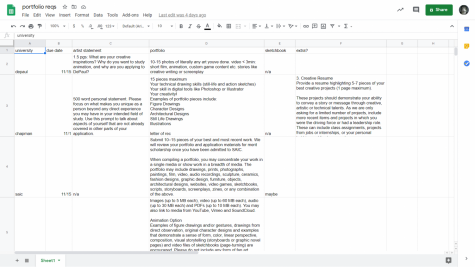Looking to Apply for an Art Major?
October 28, 2020
As early deadlines loom closer and closer, I’ve been working harder and harder to keep up with everything. Other students are working on essays, questions, and letters of rec, but students applying for visual art majors are working on portfolios, too! Here are some things to do to help you with your portfolio:
- Make a list of your colleges
Similar, to my last article, one of the first things you should do when applying to schools is research the educational institution you’re interested in, and make a list of what it offers for you. Later on, when you narrow the list down to colleges you want to apply to, make sure to take a look at their portfolio requirements for the degree you want to pursue. Then, make a spreadsheet of the requirements, so that if some overlap, you submit those same parts for each application.
Here’s an example of my spreadsheet. I’m applying for the animation degrees at these colleges.

- Look for teachers to write letters of recommendation for you
One thing that some institutions will require from you is a letter of recommendation, specifically from someone who is familiar with your artwork. My advice is that even if the school doesn’t require this, do it anyway, since it can make your application more appealing.
When asked what students can do to help art teachers write their letter of recommendation, visual arts teacher Ms. Nathan responded, “I think it’s really helpful to understand your aspiration as an artist – not just in five years, but in a few months. Tell your letter writers about what dream project you’d like to work on if given the resources, time, and support that a college would be able to provide for you.”
She expressed disappointment in not taking her art as seriously back then, since she didn’t take advantage of her institution’s resources and the ability to collaborate with other artists. Colleges will most likely provide more resources, tools, and connections then you can practically obtain after you graduate; all the resources you need to achieve your dreams will be right in front of you. You should take advantage of this!
Just email the teacher you want to request a letter of recommendation from, and make sure to add them on Naviance.
- Show off your best, most recent work
This will be the main part of your portfolio. For degrees focused on painting, drawing,
animation, or ceramics/pottery, the college will most likely ask you to submit 10-15 of your best, most recent pieces. They want you to show off your technical skills, your creativity, and the meaning behind your work, so you want to choose the pieces that reflect this.
Visual arts teacher Florian suggests:
– “Ask for help picking your best work- ask family, friends, or art teachers if you want feedback;
– Give the work the context it needs to be understood. If you can add a title or artist’s statements about your pieces, give them information about the ideas or process that went into it.
– Most schools are interested in potential, not perfection. They want to see that you have passion and ideas- so don’t be afraid to submit work even if it’s not perfect.”
They explained that colleges will either ask for a portfolio, for example, fashion illustrations or finished garments, or for film, a supercut of your best films, or they will ask you to create a piece based off of a prompt they provide. The latter is more common among arts specific universities.
Ms. Nathan advises, “When you’re building a portfolio, allow your work to tell a visual story, guiding the viewer through your thought process, passions, questions, and explorations across the artworks.” Even if you focus on one idea or process, she says that you should still show your growth over time and your curiosity about the subject.
- Prepare a portfolio sketchbook
This isn’t for all majors, but depending on what you apply for, the college might also ask for a recent sketchbook in order to see your process – how you think about the shapes that make up figures, how you distort and reimagine them, etc. On YouTube, there are plenty of examples of sketchbook walkthroughs from people who got accepted into their school. You can use these as an example of what you can showcase through your sketchbook!
- Get your portfolio reviewed
While this isn’t required, it can help out a lot to have an experienced artist’s opinion on your portfolio. You can ask teachers, experienced artists you know, and you can even sign up to have faculty from a college of interest review your portfolio. Some universities hold National Portfolio Days where you can also get your portfolio reviewed, but also get more information about the school.
One thing to keep in mind is to start early. The longer you spend on your portfolio, the cleaner it will be, and you will also be able to show your growth over time more easily. Florian says, “If you’re a younger student (not a senior) and you think you’ll want to submit artwork for your college portfolio, start making artwork now! It can be in an art class, after school program, or on your own. The more experience you have and the more work you can pick from, the easier the portfolio process is.” Don’t be discouraged if you start later, though. Building a portfolio might seem like a daunting task at first, but once you start it, it won’t seem so hard.